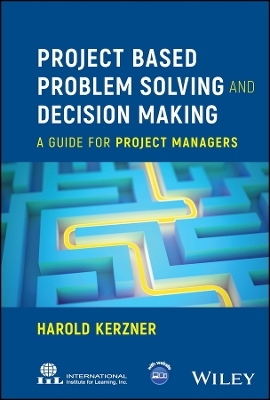
Project Based Problem Solving and Decision Making
John Wiley & Sons Inc (Verlag)
978-1-394-20783-1 (ISBN)
An everyday resource for project managers who are tasked with identifying and solving complex problems, Project Based Problem Solving and Decision Making offers valuable guidance on how to make informed decisions that move projects forward, provides project managers with expert advice for communicating clearly and effectively with team members and project stakeholders, and describes how to effectively lead project teams and empower team members to make strategic project decisions.
Written by Dr. Harold Kerzner, bestselling author and one of the leading minds in project management, Project Based Problem Solving and Decision Making includes information on:
Developing effective problem-solving and decision-making???important skills for professional project managers
Leading teams, setting and achieving goals, and making sure that projects are completed on time and within budget
Identifying and solving problems that arise during complex projects, and making informed decisions that move projects forward
Using a project-based approach: breaking the project down into smaller, manageable??chunks and tackling each one separately
Focusing on specific problems or decisions and implementing solutions tailored to the??specific needs of the project
Project Based Problem Solving and Decision Making is an essential everyday resource for professional project managers, as well as students studying project management.
Dr. Kerzner is not only a world-renowned author in project management but also serves as the Senior Executive Director at the International Institute for Learning, Inc. (IIL). To explore more about IIL’s offerings, visit www.iil.com or get in touch via email at learning@iil.com.
Harold Kerzner, PhD (Boynton Beach, FL), is Senior Executive Director for Project Management at the International Institute for Learning, Inc. (IIL), USA. International Institute for Learning, Inc. (IIL) is a global leader in professional training and comprehensive consulting services in the areas of project, program, and portfolio management, PRINCE2®, ITIL, Business Analysis, Microsoft® Office Project and Project Server, and Lean Six Sigma.
Preface xi
About the Companion Website xiii
1 Understanding the Concepts 1
1.0 The Necessity for Problem-Solving and Decision-Making 1
1.1 Problems and Opportunities 2
1.2 Research Techniques in the Basic Decision-Making Process 3
1.3 Facts About Problem-Solving and Decision-Making 4
1.4 Who Makes the Decision? 4
1.5 Information Overload 5
1.6 Getting Access to the Right Information 5
1.7 The Lack of Information 6
Discussion Questions 6
References 7
2 Understanding the Project Environment and the Impact on Problem Solving 9
2.0 Understanding the Project Environment 9
2.1 Project Versus Business Problem-Solving and Decision-Making 11
2.2 Problem-Solving and Decision-Making in the Project Management Environment 11
2.3 The Impact of Constraints on Project Problem-Solving and Decision-Making 12
2.4 The Impact of Assumptions on Project Problem-Solving and Decision-Making 13
2.5 Understanding the Project Environment’s Complexities 14
2.6 Selecting the Right Project Manager 15
2.7 The Impact of the COVID-19 Pandemic on Project Management 15
2.8 Differences Between Program and Project Problem-Solving and Decision-Making 18
2.9 Problem-Solving in Matrix Management Organizational Structures 25
2.10 The Impact of Methodologies on Problem-Solving 29
2.11 The Need for Problem-Solving Procedural Documentation 35
Discussion Questions 40
References 41
3 Understanding the Problem 43
3.0 The Definition of a Problem 43
3.1 The Time Needed to Identify a Problem 43
3.2 Not All Problems Can Be Solved 45
3.3 The Complexities of the Problems 46
3.4 Techniques for Problem Identification 46
3.5 Individual Problem-Solving Conducted in Secret 47
3.6 Team Problem-Solving Conducted in Secret 47
3.7 Decisions That Can Convert Failures into Successes 48
Discussion Questions 53
References 54
4 Data Gathering 55
4.0 Understanding Data Gathering 55
4.1 Reasons for Data Gathering 56
4.2 Data-Gathering Techniques 56
4.3 Metrics and Early Warning Indicators 57
4.4 Questions to Ask 57
4.5 Establishing Structure for Data Gathering, Problem-Solving, and Decision-Making 58
4.6 Determining the Steps 58
Discussion Questions 59
5 Meetings 61
5.0 Problem Analysis Characteristics 61
5.1 Real Problems Versus Personality Problems 62
5.2 Determining Who Should Attend the Problem-Solving Meeting 63
5.3 Determining Who Should Attend the Decision-Making Meeting 63
5.4 Creating a Framework for the Meeting 64
5.5 Setting Limits on Problem-Solving and Decision-Making 64
5.6 Identifying Boundary Conditions 65
5.7 Understanding How People React in Meetings 65
5.8 Working with Participants During the Meetings 66
5.9 Leadership Techniques During Meetings 67
5.10 Handling Problem-Solving and Decision-Making Conflicts 67
5.11 Continuous Solutions Versus Enhancement Project Solutions 68
5.12 Problem-Solving Versus Scope Creep 68
5.13 Problem-Solving and Decision-Making During Crisis Projects 69
5.14 Presenting Your Decision to the Customer 70
Discussion Questions 71
Reference 71
6 Developing Alternatives 73
6.0 Finding Alternatives 73
6.1 Variables to Consider During Alternative Analyses 74
6.2 Understanding the Features That Are Part of the Alternatives 74
6.3 Developing Hybrid Alternatives 75
6.4 Phantom Alternatives 75
6.5 Tradeoffs 76
6.6 Common Mistakes When Developing Alternatives 76
6.7 Decision-Making for Managing Scope Changes on Projects 77
Discussion Questions 80
Reference 80
7 Problem-Solving Creativity and Innovation 81
7.0 The Need for Problem-Solving Creativity 81
7.1 Creativity and Creative Thinking 81
7.2 Creativity and Innovation Thinking 82
7.3 Creativity, Innovation, and Value 82
7.4 Negative Innovation 83
7.5 Types of Innovation 83
7.6 Problem-Solving and Decision-Making Attributes That Are Difficult to Learn 84
7.7 Creativity Roadblocks 84
Discussion Questions 85
8 Problem-Solving Tools and Techniques 87
8.0 Root Cause Analysis 87
8.1 General Principles of Root Cause Analysis 88
8.2 Corrective Actions Using Root Cause Analysis 88
8.3 Root Cause Analysis Techniques 89
8.4 Brainstorming 90
8.5 Rules for Brainstorming 90
8.6 Critical Steps in Brainstorming 91
8.7 Conducting the Brainstorming Session: The Process 92
8.8 Conducting the Brainstorming Session: Evaluation 92
8.9 Brainstorming Sessions: Nominal Group Technique 93
8.10 Brainstorming Sessions: Group Passing Technique 93
8.11 Brainstorming Sessions: Team Idea Mapping Method 94
8.12 Brainstorming Sessions: Electronic Brainstorming 94
8.13 Brainstorming Sessions: Directed Brainstorming 95
8.14 Brainstorming Sessions: Individual Brainstorming 96
8.15 Question Brainstorming 96
8.16 Reasons for Brainstorming Failure 96
8.17 Virtual Brainstorming Sessions 98
Discussion Questions 100
9 Decision-Making Concepts 101
9.0 Decision-Making Alternatives 101
9.1 Decision-Making Characteristics 102
9.2 Decision-Making Participation 102
9.3 Understanding How Decisions Are Made 103
9.4 Cultures and Problem Solving 103
9.5 Routine Decision-Making 104
9.6 Adaptive Decision-Making 104
9.7 Innovative Decision-Making 105
9.8 Pressured Decision-Making 105
9.9 Judgmental Decision-Making 106
9.10 Rational Decision-Making 106
9.11 Certainty/Uncertainty Decision-Making 107
9.12 Controllable/Noncontrollable Decision-Making 107
9.13 Programmed/Nonprogrammed Decision-Making 108
9.14 Decision-Making Meetings 110
9.15 Decision-Making Stages 110
9.16 Decision-Making Steps 111
9.17 Conflicts in Decision-Making 112
9.18 Advantages of Group Decision-Making 113
9.19 Disadvantages of Group Decision-Making 113
9.20 Rational Versus Intuitive Thinking 114
9.21 Divergent Versus Convergent Thinking 114
9.22 The Fear of Decision-Making: Mental Roadblocks 115
9.23 Decision-Making Personal Biases 116
9.24 The Danger of Hasty Decisions 116
9.25 Decision-Making Styles 117
9.26 The Autocratic Decision-Maker 117
9.27 The Fearful Decision-Maker 118
9.28 The Circular Decision-Maker 119
9.29 The Democratic Decision-Maker 119
9.30 The Self-Serving Decision-Maker 120
9.31 Delegation of a Decision-Making Authority 120
9.32 Choice Elements of Decision-Making 121
9.33 Decision-Making Challenges 122
9.34 Examples of Decision-Making Challenges 123
Discussion Questions 126
References 127
10 Decision-Making Tools 129
10.0 Decision-Making Tools in Everyday Life 129
10.1 Use of Operations Research and Management Science Models 129
10.2 SWOT Analysis 130
10.3 Pareto Analysis 130
10.4 Multiple Criteria Decision Analysis 131
10.5 Paired Comparison Analysis 132
10.6 Decision Trees 132
10.7 Influence Diagrams 133
10.8 Affinity Diagrams 133
10.9 Game Theory 134
10.10 Cost-Benefit Analysis 134
10.11 Nominal Work Groups 135
10.12 Delphi Technique 136
10.13 Other Decision-Making Tools 136
10.14 Artificial Intelligence 137
10.15 Risk Management 140
Discussion Questions 142
References 142
11 Predicting the Impact 143
11.0 Evaluating the Impact of a Decision 143
11.1 Creating a Consequence Table 143
11.2 Performing Impact Analysis 144
11.3 The Time to Implement a Solution 145
11.4 The Definitions for Project Success and Failure Are Changing 145
11.5 Project Decision-Making and Politics 149
Discussion Questions 150
12 The Need for Effective or Active Listening Skills 151
12.0 Active Listening 151
12.1 Active Listening Body Language and Communications 151
12.2 Active Listening Barriers Created by the Speaker 152
12.3 Active Listening Barriers Created by the Listener 152
12.4 Overcoming Active Listening Barriers 153
12.5 Techniques for Effective Listening 153
Discussion Questions 154
13 Barriers 155
13.0 The Growth of Barriers 155
13.1 Lack of Concern for the Workers Barriers 157
13.2 Legal Barriers 160
13.3 Project Sponsorship Barriers 163
13.4 Cost of Implementation Barriers 165
13.5 Culture Barriers 166
13.6 Project Management Office (PMO) Barrier 168
13.7 Conclusion 169
Discussion Questions 169
References 170
Appendix: Using the PMBOK® Guide 173
Decision-Making and the PMBOK® Guide 173
Problem-Solving and the PMBOK® Guide 173
PMBOK® Guide: Integration Management 174
PMBOK® Guide: Scope Management 174
PMBOK® Guide: Time Management 175
PMBOK® Guide: Cost Management 175
PMBOK® Guide: Quality Management 176
PMBOK® Guide: Human Resource Management 176
PMBOK® Guide: Communications Management 177
PMBOK® Guide: Risk Management 177
PMBOK® Guide: Procurement Management 178
PMBOK® Guide: Stakeholder Management 178
Further Reading 181
Index 183
| Erscheinungsdatum | 11.11.2023 |
|---|---|
| Verlagsort | New York |
| Sprache | englisch |
| Maße | 158 x 231 mm |
| Gewicht | 363 g |
| Themenwelt | Wirtschaft ► Betriebswirtschaft / Management |
| ISBN-10 | 1-394-20783-2 / 1394207832 |
| ISBN-13 | 978-1-394-20783-1 / 9781394207831 |
| Zustand | Neuware |
| Haben Sie eine Frage zum Produkt? |
aus dem Bereich


